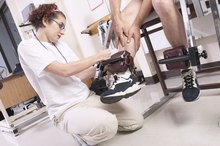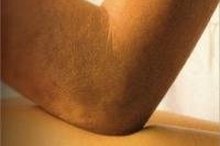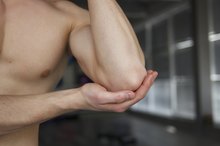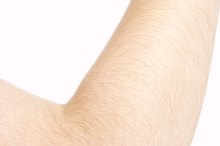What does fact checked mean?
At Healthfully, we strive to deliver objective content that is accurate and up-to-date. Our team periodically reviews articles in order to ensure content quality. The sources cited below consist of evidence from peer-reviewed journals, prominent medical organizations, academic associations, and government data.
The information contained on this site is for informational purposes only, and should not be used as a substitute for the advice of a professional health care provider. Please check with the appropriate physician regarding health questions and concerns. Although we strive to deliver accurate and up-to-date information, no guarantee to that effect is made.
Heat or Cold Therapy for Golfer's Elbow
Golfer's elbow, also known as medial epicondylitis, is a type of tendinitis 1. It occurs when the joint tendons, muscles and ligaments responsible for controlling movement of your forearm develop small tears, or micro tears. The result is pain, inflammation, restriction of movement and formation of calcium deposits and scar tissue. Besides pain, other symptoms of golfer's elbow include stiffness, weakness, tingling and numbness. At-home remedies such as heat or cold therapy help relieve these symptoms and promote healing.
If you are experiencing serious medical symptoms, seek emergency treatment immediately.
Causes of and Risk Factors for Golf Elbow
Overuse and repetitive activities that strain the muscles in your forearm are the most common causes of golfer's elbow. While the condition is called "golfer's elbow," activities such as using work tools or playing tennis increase your risk of developing it. Poor conditioning of your forearm muscles and a direct injury to your elbow are also risk factors, according to The Stretching Handbook website.
When to Use Cold Therapy
Is Ice or Heat Better for Knee Pain?
Learn More
Ice or cold therapy, or cryotherapy, is more effective at treating tendonitis when symptoms first develop, according to Edward R. Laskowski, a physical medicine and rehabilitation specialist at the Mayo Clinic 1. Ice helps to constrict blood vessels to reduce swelling and inflammation resulting from tissue injury. Cold therapy can also reduce muscle spasms and numb pain. Cold therapy includes using cold packs, bags of ice or fluids like ethyl chloride. Always place a thin cloth between your skin and the ice pack to avoid tissue damage. Limit cold therapy to 15 to 20 minutes at a time, as longer exposure can also lead to tissue damage.
- Ice or cold therapy, or cryotherapy, is more effective at treating tendonitis when symptoms first develop, according to Edward R. Laskowski, a physical medicine and rehabilitation specialist at the Mayo Clinic 1.
- Limit cold therapy to 15 to 20 minutes at a time, as longer exposure can also lead to tissue damage.
When to Use Heat Therapy
Heat opens up blood vessels and increases blood flow to your injured elbow joint, which promotes healing. It alleviates symptoms such as pain, stiffness and fluid build-up, or edema, in the tissues. However, you should not apply heat to a new injury; wait three to four days before using it or until swelling subsides. You can choose from a variety of heat therapies, according to The Merck Manuals, such as using a heat pack; soaking your elbow in warm, moving water, such as in a hot tub; using infrared heat or heated wax; or applying a medicated heat rub. Do not apply heat to any area with an open wound.
- Heat opens up blood vessels and increases blood flow to your injured elbow joint, which promotes healing.
- You can choose from a variety of heat therapies, according to The Merck Manuals, such as using a heat pack; soaking your elbow in warm, moving water, such as in a hot tub; using infrared heat or heated wax; or applying a medicated heat rub.
Considerations
Icy Hot Uses
Learn More
If you have long-standing golfer's elbow, you can use either ice or heat to relieve your pain and other symptoms. However, if you have a medical condition such as kidney disease, diabetes or nerve damage, consult your doctor before using heat therapy, cautions The Merck Manuals. Also, watch for any adverse effects from using heat rubs as some of the ingredients, such as capsaicin, can cause irritation or an allergic reactions.
Related Articles
References
- Mayo Clinic: Tendinitis
- MD Guidelines: Tendinitis
- Merck Manuals Online Medical Library: Treatment of Pain and Inflammation
- Amin NH, Kumar NS, Schickendantz MS. Medial Epicondylitis: Evaluation and Management" J Am Acad Orthop Surg. 2015 Jun;23(6):348-55.
- Jobe, FW; Ciccotti, MG. "Lateral and Medial Epicondylitis of the Elbow" J. Am. Acad. Ortho. Surg., Jan 1994; 2: 1 - 8.
Writer Bio
Kay Uzoma has been writing professionally since 1999. Her work has appeared in "Reader’s Digest," "Balance," pharmaceutical and natural health newsletters and on websites such as QualityHealth.com. She is a former editor for a national Canadian magazine and holds a Bachelor of Arts in political science from York University.









